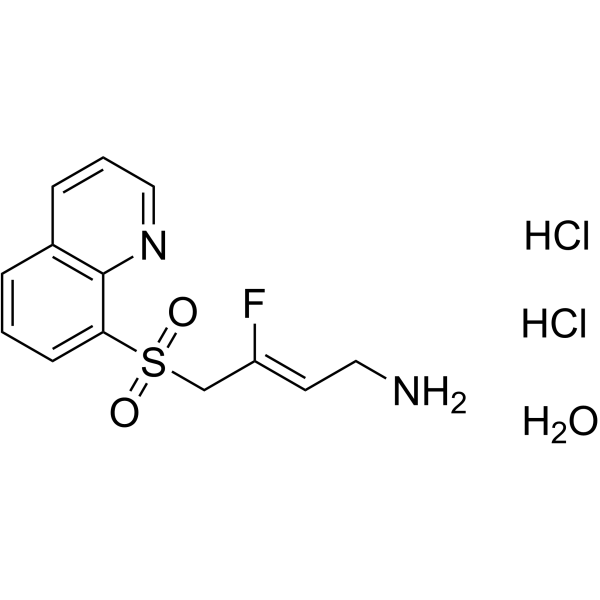2414974-55-1
| Name | LOX-IN-3 dihydrochloride monohydrate |
|---|
| Description | LOX-IN-3 dihydrochloride monohydrate (Compound 33) is an orally active lysyl oxidase (LOX) inhibitor. LOX-IN-3 dihydrochloride monohydrate can be used for fibrosis, cancer and angiogenesis research[1]. |
|---|---|
| Related Catalog | |
| Target |
IC50: <1 μM (human LOXL2), <10 μM (bovine LOX)[1] |
| In Vitro | LOX-IN-3 dihydrochloride monohydrate (Compound 33) inhibits the bovine LOX and human LOXL2 activities with IC50 values of <10 μM and <1 μM, respectively[1]. LOX-IN-3 dihydrochloride monohydrate exhibits sustained inhibition of LOXL1 and LOXL2[1]. LOX-IN-3 dihydrochloride monohydrate is less active against SSAO/VAP-1 and MAO-B activities[1]. |
| In Vivo | LOX-IN-3 dihydrochloride monohydrate (Compound 33) (30 mg/kg; orally; once) inhibits lysyl oxidase activity in rats[1]. LOX-IN-3 dihydrochloride monohydrate (10 mg/kg; orally; daily for 14 days) reduces kidney fibrosis in unilateral ureteric obstruction (UUO) mice model[1]. LOX-IN-3 dihydrochloride monohydrate (15 mg/kg; orally; daily for 21 days) reduces lung fibrosis in mice[1]. Animal Model: Male Wistar rats[1] Dosage: 30 mg/kg Administration: Oral administration, single dose Result: Completely abolished lysyl oxidase activity. Plasma concentrations of tested compound are far below the IC50 after 8 hours, the half-life of recovery is between 2-3 days (ear) and 24 hours (aorta). Animal Model: Unilateral ureteric obstruction (UUO) model of acute kidney fibrosis in mice[1] Dosage: 10 mg/kg Administration: Oral gavage, daily for 14 days Result: Increased kidney weight and thickness and reduced the area of fibrosis. Animal Model: C57Bl/6 mice, Bleomycin-induced lung fibrosis model Dosage: 15 mg/kg Administration: Oral gavage, daily for 21 days Result: Significantly reduced the Ashcroft score and the lung weight. |
| References |
| Molecular Formula | C13H17Cl2FN2O3S |
|---|---|
| Molecular Weight | 371.26 |
